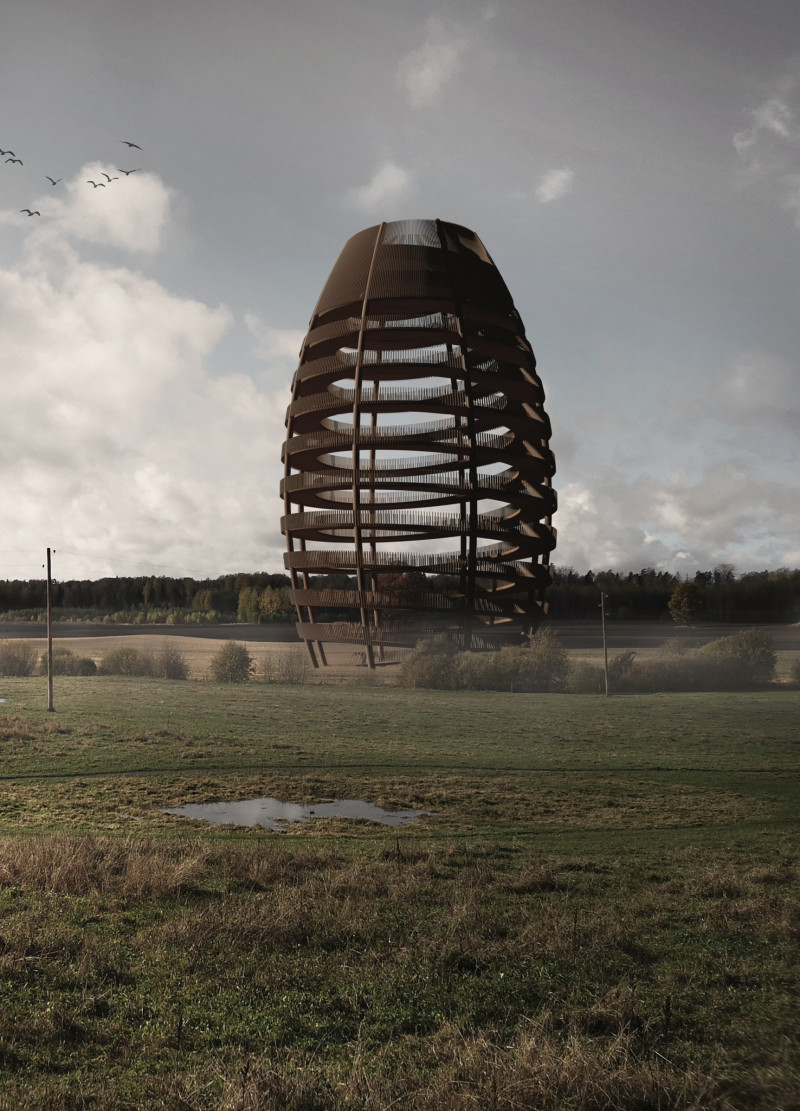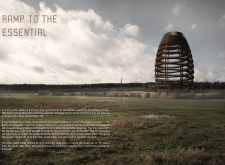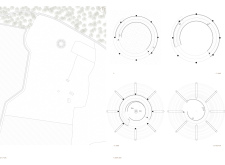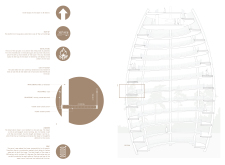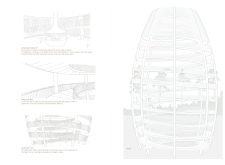A spiraling ramp constructed from Corten steel invites visitors to ascend through a carefully designed observation tower that harmonizes with the surrounding biosphere while showcasing the warmth of locally sourced wood, ultimately serving as a communal space for reflection and connection with nature.
5 key facts about this project
01
The design incorporates a gentle 5-degree gradient for universal accessibility on the spiraling ramp.
02
Corten steel cladding weathers naturally, allowing the structure to blend seamlessly with the environment.
03
Locally sourced wood is thoughtfully integrated, enhancing warmth and community connection.
04
A communal gathering space includes a fireplace, promoting social interaction among visitors.
05
The tower’s organic egg-like shape symbolizes renewal and encourages a deeper connection with nature.
General keywords
The observation tower located in the North Latvia Biosphere Reserve is a focused architectural project designed to enhance the visitor experience while maintaining harmony with the natural landscape. This structure serves the dual purpose of observation point and communal space, inviting guests to connect with their surroundings. The design prioritizes accessibility and interaction with the environment, creating a serene environment for contemplation and engagement.
The observation tower features a continuous ramp that spirals upwards, facilitating an accessible ascent for all visitors. The ramp, with a gentle gradient of 5 degrees, invites guests to experience gradual immersion in the surrounding biosphere, encouraging a chromatic and sensory engagement with the various landscapes. The summit of the tower houses a panoramic viewing platform, strategically designed to maximize visibility over the North Latvia natural scenery.
Unique Structural and Design Features
What sets this project apart from typical observation towers is its emphasis on organic form and sustainability. The structure is shaped like an elongated egg, symbolizing renewal and connection with nature. This organic design contrasts with conventional angular towers typically found in urban settings.
Utilization of materials such as Corten steel and locally preserved wood ensures not only durability but also an aesthetic that resonates with the natural environment. Corten steel’s weathering properties allow it to blend into the landscape, while the use of wood adds warmth to the visitor spaces. The incorporation of rope in the balustrades introduces a lightweight element that maintains visual continuity while being structurally sound.
The interior of the tower includes a designated community room located at the top, which features a fireplace for comfort and gathering. This space aims to foster social interaction among visitors, allowing them to reflect on their experience in a welcoming atmosphere.
Detailed Architectural Considerations
The observation tower’s design thought process includes meticulous attention to lighting and spatial arrangement. The open design facilitates natural light, enhancing the visitor experience while reducing the need for artificial illumination. Each element of the structure is aimed at minimizing environmental impact and enhancing visitor engagement.
The architectural plans include comprehensive details of the ramp, viewing platform, and community area, highlighting the thoughtful approach to accessibility. Architectural sections illustrate the proportions and relationships between spaces, while architectural designs focus on the seamless connection between interior and exterior environments. These elements are critical for understanding the project's overall intent and functionality.
For further insights into the structural and aesthetic elements of the observation tower, interested readers are encouraged to explore the complete project presentation. Engaging with architectural plans, sections, and design ideas will provide a more comprehensive understanding of this thoughtfully executed architectural project.
The observation tower features a continuous ramp that spirals upwards, facilitating an accessible ascent for all visitors. The ramp, with a gentle gradient of 5 degrees, invites guests to experience gradual immersion in the surrounding biosphere, encouraging a chromatic and sensory engagement with the various landscapes. The summit of the tower houses a panoramic viewing platform, strategically designed to maximize visibility over the North Latvia natural scenery.
Unique Structural and Design Features
What sets this project apart from typical observation towers is its emphasis on organic form and sustainability. The structure is shaped like an elongated egg, symbolizing renewal and connection with nature. This organic design contrasts with conventional angular towers typically found in urban settings.
Utilization of materials such as Corten steel and locally preserved wood ensures not only durability but also an aesthetic that resonates with the natural environment. Corten steel’s weathering properties allow it to blend into the landscape, while the use of wood adds warmth to the visitor spaces. The incorporation of rope in the balustrades introduces a lightweight element that maintains visual continuity while being structurally sound.
The interior of the tower includes a designated community room located at the top, which features a fireplace for comfort and gathering. This space aims to foster social interaction among visitors, allowing them to reflect on their experience in a welcoming atmosphere.
Detailed Architectural Considerations
The observation tower’s design thought process includes meticulous attention to lighting and spatial arrangement. The open design facilitates natural light, enhancing the visitor experience while reducing the need for artificial illumination. Each element of the structure is aimed at minimizing environmental impact and enhancing visitor engagement.
The architectural plans include comprehensive details of the ramp, viewing platform, and community area, highlighting the thoughtful approach to accessibility. Architectural sections illustrate the proportions and relationships between spaces, while architectural designs focus on the seamless connection between interior and exterior environments. These elements are critical for understanding the project's overall intent and functionality.
For further insights into the structural and aesthetic elements of the observation tower, interested readers are encouraged to explore the complete project presentation. Engaging with architectural plans, sections, and design ideas will provide a more comprehensive understanding of this thoughtfully executed architectural project.


